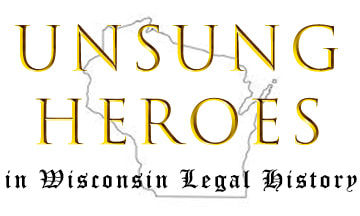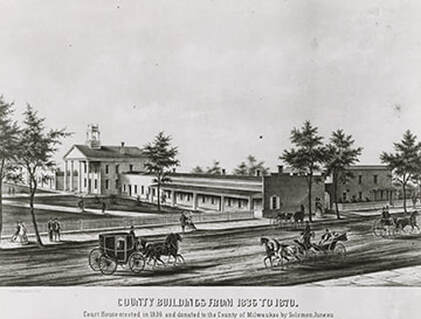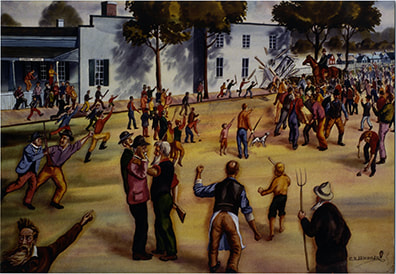Unsung hero: Joshua Glover – His escapes from slavery and the law sparked state abolitionist action12/3/2021 By Margo Kirchner First of two parts The capture and escape of Joshua Glover in southeastern Wisconsin in 1854 sparked an abolitionist outcry and an attempt by the Wisconsin Supreme Court and Legislature to nullify federal slavery law. Two years earlier, Glover had escaped from slavery in St. Louis and established a life in freedom in Racine, but federal deputy marshals captured him in his home under the Fugitive Slave Act of 1850. Outraged citizens of Milwaukee and Racine broke Glover out of jail and sent him on the Underground Railroad. Glover eventually reached safety in Canada. Although Glover departed Wisconsin by mid-April 1854, his legal impact here had just begun. His escape from custody led to a struggle between state and federal authorities and the state’s defiance of the U.S. Supreme Court. Benammi Stone Garland purchased Glover, then known only by his first name, on January 1, 1850, on the steps of the St. Louis Courthouse. In May 1852, Glover escaped from Garland’s farm and crossed the Mississippi River to Alton, Illinois. Garland placed a reward notice in a Missouri newspaper on May 19, 1852, and ran the notice for about two weeks. Glover traveled about 350 miles to Racine, arriving in late spring or early summer. Racine was a bustling community of 5,000 people due to its trading post, harbor, and plank road to Janesville. About 60 Black or mixed-race adults were recorded in the city’s 1850 census. Glover found a job at a sawmill on the Root River a few miles out of town. He chose his last name and had his own home, where he lived freely for two years. Wisconsin’s antislavery movement was active by the early 1850s. The Burlington Liberty Association, the first antislavery society in the state, had been around since 1844. Sherman Booth published an abolitionist newspaper in Milwaukee called the Free Democrat. Chauncey Olin published the abolitionist American Freeman newspaper in Waukesha. The Underground Railroad (UGRR) stopped in Waukesha and elsewhere. And, as described by authors Ruby West Jackson and Walter T. McDonald, Racine was a “hotbed of abolitionist sympathizers.”* Clayborn Benson, executive director of the Wisconsin Black Historical Society, said in a recent interview that abolitionists were motivated by several reasons. Some opposed slavery on religious grounds, while others opposed slavery for political purposes as part of the developing Republican Party. Some were European immigrants with ancestors who had been enslaved, while “free-soilists” did not want to compete against the South’s unpaid labor when it came to agriculture. Although Wisconsin’s antislavery movement was vigorous, Blacks nevertheless were not close to being treated equally with Whites. They had the right to assemble and act as jurors, said Benson. But Blacks were still denied the right to vote, and Whites did not want Blacks living nearby. In 1850 Milwaukee, about 100 Blacks lived in a city of 20,000. Political battles raged in the nation over slavery in territories and newly formed states. Sentiment ran strongly in Wisconsin against slavery and its reach northward, and there was strong opposition to returning escaped slaves who had become Wisconsin residents. Many people in Wisconsin wanted “no part of enslavement,” said Benson. Slavery’s reach from the South, however, found support in the U.S. Constitution and federal law. Article IV, section 2 of the U.S. Constitution provided that a slave in one state would not be discharged from service by escaping to another state and would be delivered back to his or her owner on demand. The Fugitive Slave Act of 1793 established a process for slave owners to reclaim runaway slaves, but in southern eyes it did not have teeth. As part of the Compromise of 1850 between northern and southern states, a new fugitive slave act beefed-up the rights of slave owners to recover escaped slaves. A slave owner could obtain a court order in his home state confirming the status of a slave, then proceed to find and arrest the escapee with the assistance of federal marshals. A U.S. commissioner, rather than a regular district judge, could determine the fate of the person. Notably, the commissioner received a larger fee for sending a fugitive to slavery than for releasing him or her. The alleged fugitive slave was denied a jury trial or any other opportunity for testimony or defense. Moreover, the act created criminal penalties for citizens who helped escaped slaves or interfered with their return. This is the first of two posts about Joshua Glover. Read the second one here. The Fugitive Slave Act of 1850 “brings fire” to northern abolitionists and made them determined to help fugitives reach Canada, said Benson. Wisconsin politics included disagreements regarding whether the state had to defer to the federal government’s efforts to enforce the 1850 act. From 1850 to 1860 “there is turmoil,” Benson said. Garland remained intent on reclaiming Glover under the 1850 act. He somehow learned that Glover was in Wisconsin and provided a St. Louis court with proof of his ownership and Glover’s escape. The court ordered Glover’s removal from Wisconsin. Garland arrived in Milwaukee in early March 1854 with a St. Louis police officer and the Missouri court order. He swore out an affidavit and presented his paperwork to U.S. District Judge Andrew G. Miller, who issued a warrant for Glover’s arrest. Deputy U.S. Marshal Charles Cotton accompanied Garland and the St. Louis police officer to Racine, where they were joined by another federal deputy marshal. Garland and the officers surprised Glover at his home on Friday, March 10, 1854. After a physical struggle the officers subdued Glover and led him away in shackles. Several reports indicate that Glover was bruised and bloodied during the capture. Possibly because of the small size of the Racine jail or the abolitionist forces in Racine, the captors transported Glover to Milwaukee County’s larger and stronger jail located in Courthouse Square (now Cathedral Square). Jailing Glover in Milwaukee also facilitated a quicker hearing because the commissioner and federal judge were located there. The one courthouse contained the federal district court, Milwaukee County courts, and county jail. News of Glover’s capture spread through Racine. The editor of the Racine abolitionist newspaper printed a story in his Saturday edition and telegraphed word of the “kidnapping” to Booth in Milwaukee by early Saturday morning. Booth’s inquiries with a deputy marshal and Judge Miller on Saturday, March 11 went nowhere, but Booth found out that Glover was in the Milwaukee jail. Booth printed and distributed a handbill about the jail being “used for the slave-catchers.” The handbill read: Last night a colored man was arrested near Racine, on a warrant of Judge Miller by Deputy Sheriff Cotton and making some resistance, was knocked down and brought to this City, and incarcerated in the County Jail. Marshal Cotton denied knowing anything about it at 9 o’clock this morning. The object evidently is to get him a secret trial without giving him a chance to defend himself by counsel. Citizens of Milwaukee! Shall we have Star Chamber proceedings here? And shall a man be dragged back to Slavery from our Free Soil, without an open trial of his right to Liberty? Watch your jail, your District and U.S. Commissioners’ Courts! An attorney in Milwaukee prepared and served on the sheriff and marshal an application for writ of habeas corpus (a legal claim that a detention is illegal), signed by a Milwaukee County judge, directing the U.S. marshal to bring Glover before the judge and justify his detention. The sheriff, marshal, and Judge Miller refused to release Glover on the writ of habeas corpus. Meanwhile, Miller set a hearing in the case of Garland versus Glover in federal court for Monday. In Racine, a large group gathered in Haymarket Square (now Monument Square) demanding a fair trial for Glover and his release. A Racine judge issued an arrest warrant for Garland and Cotton for assault and battery on Glover, and 100 men agreed to accompany the Racine County sheriff to Milwaukee to arrest the captors. Booth rode his horse around Milwaukee calling for citizens to gather at Courthouse Square. By 2:30 p.m., at least 500 and possibly 1,000 or more people, Black and White, filled the square. Several city leaders, including General Paine; his son, Byron Paine (later an attorney for Ezekiel Gillespie in his case securing the right to vote); and lawyer John Rycraft created a “vigilance committee” to ensure that Glover’s rights were protected. Speeches and crowd responses were loud, and outrage grew. Byron Paine explained how the Fugitive Slave Act of 1850 was unconstitutional because it denied the alleged escapee the writ of habeas corpus and right to trial by jury. Charles Watkins, an attorney and abolitionist, told the crowd that there were times when people must take the law into their own hands or themselves become slaves. The Racine abolitionists arrived in Milwaukee by boat around 5:00 p.m., bringing the warrant for the arrest of Garland and Cotton. After the vigilance committee announced the marshal’s continued refusal to release Glover, the agitated crowd rushed toward the jail, kicked in an outer door, and used pickaxes to knock down part of a wall. Years later, James Angove recounted for the Milwaukee Sentinel what happened next: I was a young fellow then, and happened to attend the meeting. I was also there when they went to the Court house to demand the prisoner. There was a large crowd. The leaders demanded the keys of the jail, but the jailor refused. The crowd stood still. The lumber for St. John’s cathedral, then in process of erection, was all over the street. When the jailer refused the keys, I picked up a six-inch beam and said to the crowd “Here’s a good enough key.” Several men used the beam as a battering ram to break into the jail cell and release Glover. A witness later wrote that as Glover was sprung from jail, the U.S. Marshal arrived “and for about twenty minutes or half an hour the devil was to pay,” but the crowd kept Glover away from the marshal and his deputies. As Glover was sprung from jail, the U.S. Marshal arrived “and for about twenty minutes or half an hour the devil was to pay,” but the crowd kept Glover away from the marshal and his deputies. Glover was quickly carried to a wagon and spirited away across the Milwaukee River to Walker’s Point and then perhaps to a barn on Fond du Lac Avenue. Glover transferred to a faster buggy, driven by John Messenger, which sped to the home of an avid abolitionist in Waukesha. Glover then entered the UGRR system.
Telegraph messages announced his release to those waiting in Racine. People in Racine did not necessarily like Glover, said Benson. Nevertheless, according to a story in the Racine Advocate the next day, “cannon were fired, bonfires lighted, bands of music patrolled the streets . . . at the triumph of humanity over brutality and the slave driver’s power.” Glover spent the next few weeks moving through UGRR stations in Waukesha, Racine, and Walworth Counties before returning to Racine and boarding a ship, probably in early April 1854. Glover traveled over Lake Michigan and Lake Huron and likely disembarked at Owen Sound or Collingwood in Ontario, Canada. Canada had formally abolished slavery in the 1830s. By April 19, 1854, Glover made his way to Etobicoke, a town outside Toronto. At the time, about three dozen Blacks from the U.S. lived there. Thomas Montgomery hired Glover to work on his farm and at the Montgomery Inn. Glover rented a home from Montgomery and married a white Irish woman named Ann. They raised crops and animals while Glover continued to work for Montgomery. According to artist Quentin VerCetty, who researched Glover before creating a statue of him, Glover’s first marriage was one of the first documented interracial marriages in the area. After Ann died, Glover married another white woman named Mary Ann. Glover died in June 1888 at around 80 years of age. * Ruby West Jackson & Walter T. McDonald. Finding Freedom: The Untold Story of Joshua Glover, Runaway Slave. Wisconsin Historical Society Press, 2007. Next: Wisconsin challenges the U.S. Supreme Court.
0 Comments
Your comment will be posted after it is approved.
Leave a Reply. |
Donate
Help WJI advocate for justice in Wisconsin
|
Copyright © 2024 Wisconsin Justice Initiative Inc.
The Wisconsin Justice Initiative Inc. does not endorse candidates for political office. The Wisconsin Justice Initiative Inc. is a 501(c)3 organization.
The Wisconsin Justice Initiative Inc. does not endorse candidates for political office. The Wisconsin Justice Initiative Inc. is a 501(c)3 organization.




 RSS Feed
RSS Feed